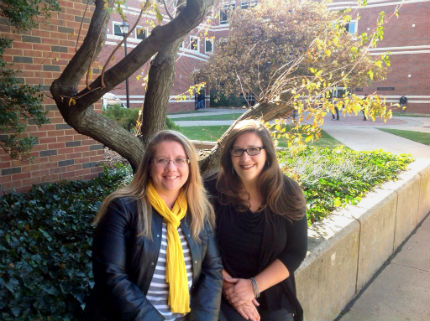Wichita State University’s School of Social Work has educated students to fight for equality, social justice and change since 1967, but in less than three years the program has increased its reach by 140 percent using social media. Not only is the school connecting with more students online, but they are reaching out to prospective students, practicing social workers, alumni and other departments at the university.
Today, social media is being used as a teaching tool for social work students at Wichita State, and the two educators responsible for driving the online efforts are seeking to share what they’ve learned with colleagues in other disciplines.
There was a lot of conversation among the faculty about the potential for social media in their profession, but Shaunna Millar, clinical educator and BSW program director, and Natalie Grant, assistant professor at the School of Social Work, made it a reality.
“We kind of spearheaded it,” said Millar, “but there’s been a lot of support in the department across the board, from directors and other faculty here.”
“It started because we understood that Facebook was being used not just for personal communication,” said Grant, “but as a way for us to communicate with our students.”
At first, the School of Social Work’s presence online was limited to a single page devoted to the Student Organization of Social Work, but it developed quickly from there.
“I think we all underestimated its utilization,” Millar admitted. “As we started to bridge into social media and develop pages, it started to extend into other areas with Facebook, Pinterest and Twitter.”
It seems logical that you’d find social workers being drawn to the places where the people are. These days, those places are usually found online.
“It’s one of our core values that we go where our clients are, and our clients in the sense of social work education are our students,” said Millar
Extending their reach
“We got really excited because we found that we had not only current students accessing our social media,” said Millar, “but we also had prospective students, alumni and people who were just interested in our field stumble across our page on Facebook. We went from having a pretty small reach to having thousands of people, not just from the Wichita area but from across the state, across the country and all over the world. That was very illuminating for us how quickly that reach extended.”
Modeling the advantages of social media to other departments at WSU wasn’t a goal when Millar and Grant began their efforts, but it has become an opportunity for them to improve their professional relationships across the university.
“We have a finite amount of time and opportunity to be able to see people face to face,” said Millar, “and we want to be able to do that efficiently and effectively. With a multi-disciplinary approach to working with people, students are going to get valuable things from other departments outside of social work, and we want other students to get that human service aspect that comes from social work practices.”
Working with other disciplines has helped raise awareness of the need to have a multidisciplinary element in all fields at Wichita State. From other disciplines, the School of Social Work has learned lessons that help them connect in ways that would never have happened in traditional channels of communication.
“There’s a reciprocity,” said Millar. “They connected with our goals as a department and it helps us want to understand and learn their department’s goals so we can support those too. That kind of collaboration has been taken to a whole other level.”
In their work with other departments, it became apparent that there was a divide between those who were benefiting from social media and those who were not. Those who were most involved seemed to be organizations designed to support students, and Millar and Grant decided to bring those other departments into the social media discussion to create a “virtual communication community.”
Benefit to students
Millar and Grant discovered that by engaging students through social media, the distribution of information became a collaborative effort. Social media became not just informational but formational, and helped reinforce elements of the profession such as cornerstone values.
As the school integrated social media into teaching, students learned how to present themselves professionally, and the values and ethics critical to being a social worker were brought into play sooner in the education process. They began having conversations about what kind of information was appropriate to put online and about dual relationships. Many of the students learned to use social media in ways that would benefit them professionally because they belonged to the school.
Expanding the school’s reach online is good for more than just learning about social work. For students engaged in social media campaigns there is an element of entrepreneurialism and leadership they discover, as well as technological and creative skills.
“This has been so valuable for our students,” said Grant. “They’re able to take these experiences with social media and apply it when they start working in the community. By having this model from the university, by having the discussions and training points we’re able to do, students are then able to make an impact.”


 Travis Gillespie
Travis Gillespie